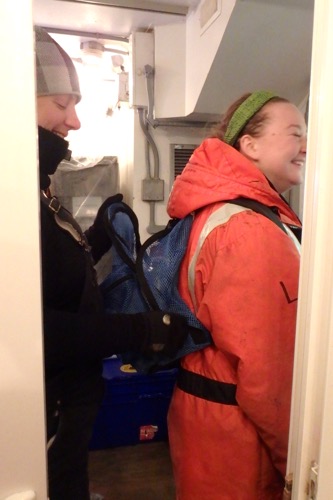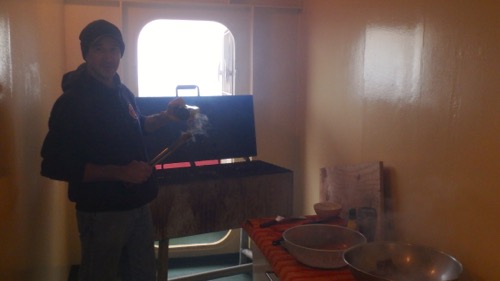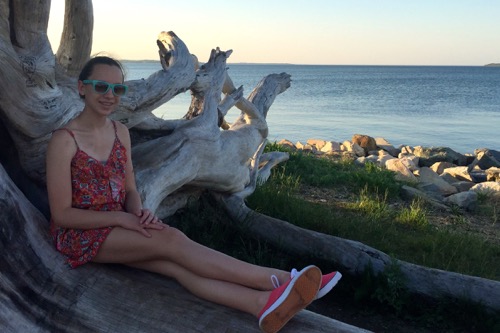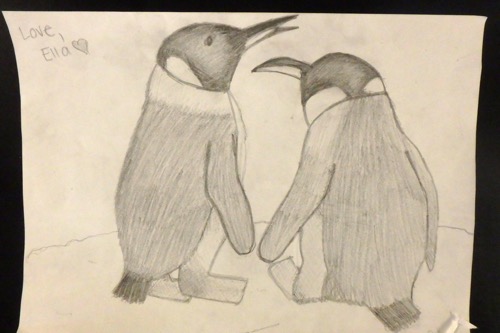Science Update - Incubation 1 & 2 Underway
Yesterday, we collected seawater samples for Incubation 2. The weather continued to worsen during the day, so it was an all-hands operation to make sure that we could get the third cast done before the weather shut down the operation. This meant sending out a third cast while still filling bottles from the second cast. In the end, it all worked out and 40+ bottles were stored in the incubation van to begin Incubation 2. The science team modified the plan for Incubation 2 based on water samples from the area and the time remaining on the ship.

Although we are on the RVIB Palmer until October 14th, we have to take into account the multiple day crossing of the Drake PassageStrait, connecting the Atlantic and Pacific oceans between Tierra del Fuego and the South Shetland Islands. Located about 100 mi (160 km) north of the Antarctic Peninsula, it is 600 mi (1,000 km) wide. and the day-long travel along the coast of Argentina and through the Straits of Magellan. This leaves us with about two more weeks of work days before experiments must be broken down and we begin to pack. In that time, we must finish Incubation 1 and 2 and set-up and run Incubation 3. There will also be samples to pack and label for immediate shipment to universities and research institutions. Other, smaller, experiments are also on-going and will need to wrap up in that time. We have weather and time to contend with as we make the final push to finish all of the planned science for this cruise, so we will take the opportunity to sample and filter every chance we get. Of course, we also need to eat. Our head cook, Michael Belloli fired up the grill and treated us to grilled chicken, steak, sausage, corn and other veggies. It was the perfect way to warm up after a long day in the cold trace metal van.

Batten Down the Hatches
Speaking of the Drake PassageStrait, connecting the Atlantic and Pacific oceans between Tierra del Fuego and the South Shetland Islands. Located about 100 mi (160 km) north of the Antarctic Peninsula, it is 600 mi (1,000 km) wide. - we are heading back to the deep water area later today to collect more seawater samples for the next series of experiments. We are hoping for a small weather window that will allow us to sneak out into the Drake, collect our samples, and then head back to the Peninsula to continue sampling along the Palmer LTER grid. Once the incubation sampling is complete this afternoon, we will secure everything and head back out to sea.
Happy Birthday
We just passed the halfway point of the research cruise. It feels like I have been on the ship for a while, but at the same time, it feels like we are just getting started. It is hard to explain. If there is one thing that is difficult about being at sea for long periods of time, it is the inability to easily communicate with friends and family. I am fortunate to have unlimited email capabilities from the ship and more Internet access than I expected upon my arrival, but it can still be difficult to not text, call or drive to someone's house whenever you want. So today, I am just going to dedicate this journal to the one person that I would like to be with today, my niece Ella. She is 13 today!

I am so overwhelmed by what a wonderful young lady she is and her amazing support of all the crazy adventures that I pursue. I wish that I could be with her, but instead, I will share with you the picture that she drew for me about two weeks before I left for this trip. She is incredibly skilled in drawing and other art projects and I knew she would make something great. She sat down on the couch and drew this without even looking at another image (as far as I know). She is a special lady, and today is all about her. I may be thousands of miles away, but I am thinking of her every second on her special day! HAPPY BIRTHDAY ELLA, I LOVE YOU!!!



Comments